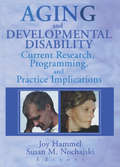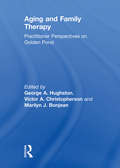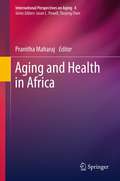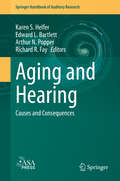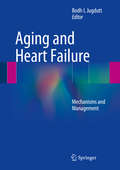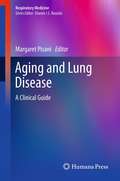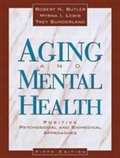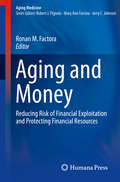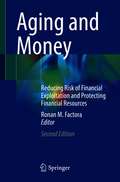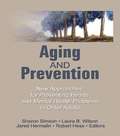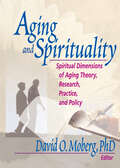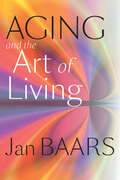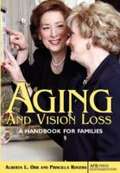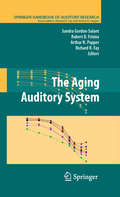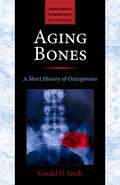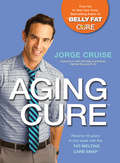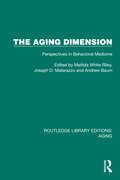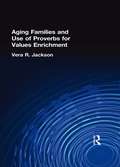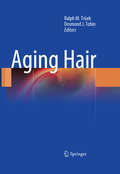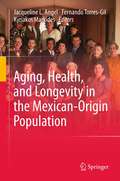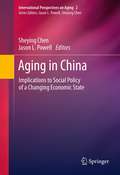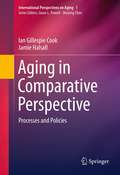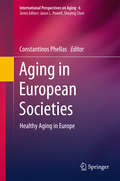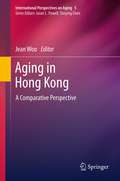- Table View
- List View
Aging and Developmental Disability: Current Research, Programming, and Practice Implications
by Joy Hammel Susan NochajskiAging and Developmental Disability: Current Research, Programming, and Practice Implications explores research findings and their implications for practice in relation to normative and disability-related aging experiences and issues. This valuable book discusses the effectiveness of specific interventions targeted toward aging adults with developmental disabilities such as Down's Syndrome, cerebral palsy, autism, and epilepsy, and offers suggestions for practice and future research in this area.
Aging and Family Therapy: Practitioner Perspectives on Golden Pond
by George Hughston Victor Christopherson Marilyn BojeanEnhance the intervention strategies you use in therapy with older adults and their families. This significant new book provides practitioners with information, insight, reference sources, and other valuable tools that will contribute to more effective intervention with the elderly and their families. Outstanding scholars have contributed original material that addresses the major issues in treating the elderly from the practitioner’s point of view; the biological, psychological, social, and spiritual concerns of the aged are examined in order to formulate a systemic and comprehensive treatment plan. Destined to become a classic in a challenging new area of psychotherapy, the unique Aging and Family Therapy promises to guide and inform practitioners who will be called upon to provide assistance to the increasing number of older adults who will be in need of mental health services.
Aging and Health in Africa (International Perspectives on Aging #4)
by Pranitha MaharajPopulation aging is a matter of global concern. It often occurs in tandem with changes in the health profile of the population. In Africa, many countries are already facing a high burden of communicable diseases. However, as more and more children survive childhood and move on to adult years and old age they are also more likely to experience health problems associated with the aging process. Population aging in Africa is occurring in the context of high levels of poverty, changing family structures, an immense disease burden, fragile health systems and weak or poorly managed government institutions. This book shows that aging is likely to lead to increased social and economic demands for the continent. However, most national governments in Africa have not begun to address the issue of how to respond effectively to the needs of the older population. This will require a better understanding of the socio-economic and demographic situation of the older population in Africa. This book fills the gaps that exist by exploring the social realities of population aging in Africa. It also focuses on the policy and programmatic responses, gaps and future challenges related to aging across the continent.
Aging and Hearing: Causes and Consequences (Springer Handbook of Auditory Research #72)
by Karen S. Helfer Edward L. Bartlett Arthur N. Popper Richard R. FaySince the first edition of the Aging Auditory System volume (in 2009), there has been a tremendous amount of research in basic, translational, and clinical sciences related to age-related changes in auditory system structure and function. The new research has been driven by technical and conceptual advances in auditory neuroscience at multiple levels ranging from cells to cognition. The chapters in Aging and Hearing: Causes and Consequences span a broad range of topics and appeal to a relatively wide audience. Our goal in this volume is to put together state-of-the-art discussions about new developments in aging research that will appeal to a broad audience, serving as an important update on the current state of research on the aging auditory system. This update includes not only the recent research, but also consideration of how human and animal studies or translational and basic research are working in tandem to advance the field. This new edition is a natural complement to the previous SHAR volume on the aging auditory system edited by Gordon-Salant, Frisina, Popper, and Fay.The target audience for this volume will be graduate students, researchers, and academic faculty from a range of disciplines (psychology, hearing science/audiology, physiology, neuroscience, engineering). It also will appeal to clinical audiologists as well as to researchers working in the hearing device industry. Individuals who attend conferences sponsored by the Association for Research in Otolaryngology, Acoustical Society of America, Auditory Cognitive Neuroscience Society, American Auditory Society, Society for Neuroscience, American Speech, Language and Hearing Association, and the American Academy of Audiology (among others) are likely to find value in the volume.
Aging and Heart Failure: Mechanisms and Management
by Bodh I. JugduttThis book synthesizes the major research advances in molecular, biochemical and translational aspects of aging and heart failure over the last four decades and addresses future directions in management and drug discovery. It presents clinical issues and molecular mechanisms related to heart failure, including the changing demographics in the aging population with heart failure; hypertension and prevention of diastolic heart failure in the aging population; polypharmacy and adverse drug reactions in the aging population with heart failure; changes in the heart that accompany advancing age from humans to molecules; aging-associated alterations in myocardial inflammation and fibrosis and aging-related changes in mitochondrial function and implications for heart failure therapy. The book succinctly summarizes the large volume of data on these key topics and highlights novel pathways that need to be explored. Featuring contributions from leading clinician-scientists, Aging and Heart Failure: Mechanisms and Management is an authoritative resource on the major clinical issues in heart failure therapy in the elderly for cardiologists, gerontologists and internists.
Aging and Lung Disease: A Clinical Guide (Respiratory Medicine)
by Margaret PisaniPeople age 65 and older are the fastest growing segment of the U.S. population. In the 2010 census 16% of the population, 50 million people, were age 65 and older. That number is projected to increase to 66 million by the year 2050. Life expectancy has also increased, with recent CDC reports indicating life expectancy at 77.9 years. Age-adjusted death rates have decreased significantly with the largest changes occurring in older patients. Despite these trends, the 10 leading causes of death include several pulmonary etiologies including lung cancer, chronic respiratory diseases, influenza and pneumonia. Aging and Lung Disease: A Clinical Guide is devoted to understanding the impact of respiratory diseases in older patients. It includes reviews of physiology of the aging lung, allergy and immunology of the aging, as well as sleep changes over the life cycle. There are also comprehensive reviews on specific disease topics including chronic obstructive lung disease, lung cancer, atypical mycobacteria, interstitial lung disease, pulmonary hypertension, pulmonary embolism, obstructive sleep apnea, sleep disorders in older patients. Two chapters focus on unique issues in older patients; HIV and lung transplant. Included also are important chapters on assessing functional and cognitive status and end-of-life issues in older patients with lung disease. In addition to outlining the current state of knowledge, each chapter focuses on special considerations when caring for older patients. Of particular interest to pulmonologists, internists, and gerontologists, other readers, such as pulmonary and geriatric nurse practitioners, as well as clinical researchers interested in both pulmonary and aging issues, will find Aging and Lung Disease: A Clinical Guide to be a vital resource for improving their care of older patients with lung disorders.
Aging and Mental Health: Positive Psychosocial and Biomedical Approaches
by Robert N. Butler Myrna I. Lewis Trey SunderlandDesigned for professionals working with the elderly, this text provides comprehensive coverage of the ageing process and its effects on mental health. It sets out the nature and problems of old age, including the problems of older people in their families, and explores some of the common emotional problems and psychiatric disorders which can affect the elderly. It also outlines the evaluation, treatment and prevention of some common effects of ageing. There is specific coverage of race, ethnicity, gender, crime, alcoholism and physical disabilities, including deafness and blindness.
Aging and Money: Reducing Risk of Financial Exploitation and Protecting Financial Resources (Aging Medicine)
by Ronan M. FactoraIncreasingly, we hear of more and more elders falling victim to financial exploitation. Although this form of elder abuse has been recognized for years, its incidence, prevalence, and impact on the common individual has been only more recently brought to the spotlight. Despite these circumstances, recognition of risk factors and indicators of financial exploitation are not widely disseminated. Additionally, once situations are identified and confronted, the knowledge of what to do next is lacking. These gaps are present within the medical community, law-enforcement, and the finance community - areas where opportunities for recognition and intervention are common. Our elders often have no idea of what to do when they see their own risk or when they fall victim. Aging and Money: Reducing Risk of Financial Exploitation and Protecting Financial Resources helps clinicians to integrate identification of such indicators of abuse into their geriatric assessment as well as guide them in performing an assessment of an individuals' financial decision making capacity when appropriate. Aging and Money: Reducing Risk of Financial Exploitation and Protecting Financial Resources is an essential new text that provides the practicing clinician with information on identifying risk factors and clinical clues associated with financial exploitation and how to incorporate these steps into their practice.
Aging and Money: Reducing Risk of Financial Exploitation and Protecting Financial Resources (Aging Medicine Ser.)
by Ronan M. FactoraThis book aims to disseminate and share knowledge about financial exploitation of elders with the purpose of protecting those individuals in our society who are most vulnerable to financial abuse and mistreatment. It instructs practicing clinicians in identification of risk factors, recognition of signs, and implementation of screening methods to protect their patients. This updated edition expands upon and advances the earlier text by including the most recent research and methods used to assess risk of financial exploitation, as well as updates in how the law approaches such cases. It also highlights ways in which community awareness can aid in identifying those most at risk, effectively protecting the elderly community, advocating for those victimized, and pursuing perpetrators to the fullest extent of the law. Professionals from law enforcement, medical clinics, financial institutions, and the legal field are now tasked with acting on suspected situations thanks to increasing recognition of financial abuse and mistreatment of an aging population. This book also guides professionals on how to discuss this information with potential victims. This second edition of Aging and Money expands the knowledge base to highlight the perspectives of different disciplines including professionals in medicine, law, the financial industry, and social services who play an important role in investigating and preventing financial abuse of the elderly.
Aging and Prevention: New Approaches for Preventing Health and Mental Health Problems in Older Adults
by Robert E HessRenowned specialists on aging explore the meaning of prevention and provide practical information about programs and services for the elderly. Interesting chapters focus on the prevention of long-term care institutionalization, alternative health delivery systems, informal support networks, and the prevention of domestic neglect and abuse of elderly adults.
Aging and Spirituality: Spiritual Dimensions of Aging Theory, Research, Practice, and Policy
by David O. MobergExplore the spiritual dimensions of aging through science, theory, and practice!During the later years of life, many people devote energy to a process of spiritual awakening and self-discovery. Yet their family, friends, clergy, and the helping professionals who work with them are not always prepared to understand or deal with the spiritual concerns of their clients. Aging and Spirituality provides a unique, far-reaching overview of this long-neglected field.Divided into four independent but interwoven sections, this landmark book covers the spiritual realm with scientific rigor and deep human understanding. Aging and Spirituality comprehensively surveys the issues of spirituality, from the groundwork of basic definitions to detailed assessments of the role spirituality plays in the lives of the elderly and suggested directions for further research. This book's unique approach combines scholarly research and practical nuts-and-bolts suggestions for service delivery. By drawing from many disciplines and professions, it offers fresh perspectives to even those practitioners already familiar with the most effective spiritual techniques their own field can offer. Aging and Spirituality answers such common questions as: What are the spiritual needs of people later in life? Is there any solid evidence that prayer changes things? How is spirituality related to physical and mental health? Does spirituality matter when people know they are dying? How can we measure spiritual wellness and assess the outcomes of activities intended to enhance it? Will attention to spirituality aggravate or alleviate the losses--of friends, family, health, youth--that so often occur during old age?Aging and Spirituality provides a much-needed resource for health care professionals, clergy, social workers, and counselors working with geriatric clients. By integrating spiritual issues into the theoretical framework of social gerontology, Aging and Spirituality will help you understand the scientific foundations, practical applications, and public policy implications of spirituality for older adults.
Aging and the Art of Living
by Jan BaarsBaars explores philosophers from Plato to Foucault as they consider the meaning of aging—and wisdom—in our society.In this deeply considered meditation on aging in Western culture, Jan Baars argues that, in today’s world, living longer does not necessarily mean living better. He contends that there has been an overall loss of respect for aging, to the point that understanding and "dealing with" aging people has become a process focused on the decline of potential and the advance of disease rather than on the accumulation of wisdom and the creation of new skills. To make his case, Baars compares and contrasts the works of such modern-era thinkers as Foucault, Heidegger, and Husserl with the thought of Plato, Aristotle, Sophocles, Cicero, and other Ancient and Stoic philosophers. He shows how people in the classical period—less able to control health hazards—had a far better sense of the provisional nature of living, which led to a philosophical and religious emphasis on cultivating the art of living and the idea of wisdom. This is not to say that modern society’s assessments of aging are insignificant, but they do need to balance an emphasis on the measuring of age with the concept of "living in time." Gerontologists, philosophers, and students will find Baars' discussion to be a powerful, perceptive conversation starter.
Aging and Vision Loss: A Handbook for Families
by Alberta Orr Priscilla RogersAs the number of older persons experiencing vision loss continues to soar over the upcoming years, all of us may find that a family member or friend we care about has become visually impaired. Aging and Vision Loss contains reassuring, supportive, and helpful information on meeting the needs of the older person and family caregivers as well.
The Aging Auditory System
by Robert D. Frisina Arthur N. Popper Sandra Gordon-Salant Richard R. FayThis volume brings together noted scientists who study presbycusis from the perspective of complementary disciplines, for a review of the current state of knowledge on the aging auditory system. Age-related hearing loss (ARHL) is one of the top three most common chronic health conditions affecting individuals aged 65 years and older. The high prevalence of age-related hearing loss compels audiologists, otolaryngologists, and auditory neuroscientists alike to understand the neural, genetic and molecular mechanisms underlying this disorder. A comprehensive understanding of these factors is needed so that effective prevention, intervention, and rehabilitative strategies can be developed to ameliorate the myriad of behavioral manifestations.
Aging Bones: A Short History of Osteoporosis (Johns Hopkins Biographies of Disease)
by Gerald N. GrobHow osteoporosis went from a normal aging process to a disease.In the middle of the twentieth century, few physicians could have predicted that the modern diagnostic category of osteoporosis would emerge to include millions of Americans, predominantly older women. Before World War II, popular attitudes held that the declining physical and mental health of older persons was neither preventable nor reversible and that older people had little to contribute. Moreover, the physiological processes that influenced the health of bones remained mysterious. In Aging Bones, Gerald N. Grob makes a historical inquiry into how this one aspect of aging came to be considered a disease.During the 1950s and 1960s, as more and more people lived to the age of 65, older people emerged as a self-conscious group with distinct interests, and they rejected the pejorative concept of senescence. But they had pressing health needs, and preventing age-related decline became a focus for researchers and clinicians alike.In analyzing how the normal aging of bones was transformed into a medical diagnosis requiring treatment, historian of medicine Grob explores developments in medical science as well as the social, intellectual, economic, demographic, and political changes that transformed American society in the post–World War II decades.Though seemingly straightforward, osteoporosis and its treatment are shaped by illusions about the conquest of disease and aging. These illusions, in turn, are instrumental in shaping our health care system. While bone density tests and osteoporosis treatments are now routinely prescribed, aggressive pharmaceutical intervention has produced results that are inconclusive at best. The fascinating history in Aging Bones will appeal to students and scholars in the history of medicine, health policy, gerontology, endocrinology, and orthopedics, as well as anyone who has been diagnosed with osteoporosis.
The Aging Cure: Reverse 10 Years In One Week With The Fat-melting Carb Swap
by Jorge CruiseFor years, experts have told you that if you want to look and feel younger, you must resort to surgeries, creams, or expensive vitamins. Others have told you to simply give up. They were WRONG. The solution is a diet that avoids hidden sugar and is rich in antioxidants. This easy guide makes anti-aging effortless and affordable. It includes more than 300 options customized for carb lovers, chicken and seafood fans, meat lovers, vegans, and vegetarians. Get ready for a fresh start to your life! Angie lost 92 lbs. Amy lost 40 lbs. Jorge lost 40 lbs.
The Aging Dimension: Perspectives in Behavioral Medicine (Routledge Library Editions: Aging)
by Matilda White Riley Joseph D. Matarazzo Andrew BaumOriginally published in 1987, this volume, and the working conference that preceded it, broke new ground in addressing the complex topic of aging, health, and behavior. Taking a bio-behavioral approach to a range of topics, contributors to this book advanced their disciplines. This volume as well as searching for important interfaces between behavior and health also added the dynamic aspect of aging. Cells, organ systems, and whole human beings all change as they move through life, linking health in varied and intricate ways to changes in behavior patterns, social structures, and cultural values and norms.
Aging Families and Use of Proverbs for Values Enrichment
by Vera R JacksonThose providing services to older persons must develop intervention strategies that are relevant to their clients’life experiences. Aging Families and Use of Proverbs for Values Enrichment presents administrators, practitioners, educators, researchers, and students with intervention models that acknowledge and build upon the proverbs orientation of the older client. This insightful book offers information from contributing authors who have professional and personal experience with the use of proverbs. Proverbs, pithy sayings that underline basic life truths, are shown in this book to work as transmitters of values and as assessment tools.To improve the ability of service programs addressing the needs of older persons, Aging Families and Use of Proverbs for Values Enrichment delineates existing approaches that are low-cost or no cost to the service provider and beneficial to older persons. Moreover, these practices are considered within the context of a conceptual model of proverbs intervention programs for older persons that takes into consideration principles of care, cultural diversity, and family traditions. Contributors examine human competencies, coping mechanisms, and limitations, as well as other more general topics: Rehabilitation: Dispels the myth that older persons can not break long-term habits and learn new things that will improve their lives. Intergenerational Transmission: Discusses family-oriented and cultural values that are passed down from generation to generation via oral tradition. Coping with Life Events: Addresses proverbs as coping mechanisms for surviving the social transitions of life. Health and Health Care: Dispels the myth that some health care practices are taboo among older persons. Cultural and Family Ties: Discusses proverbs as the cornerstone of family sharing regarding life’s lessons. Spirituality: Contrasts African American religiosity with spirituality. Discusses proverbs as messages of faith and hope.Any person who provides services to older persons--social workers, counselors, physicians, nurses, ministers and other members of the clergy, speech and physical therapists, rehabilitation counselors, and family therapists--can benefit from using proverbs, as shown in this book, in their care approach.
Aging Hair
by Ralph M. Trüeb Desmond TobinThe scalp and hair are subject to both intrinsic or physiologic aging and extrinsic or premature aging caused by external factors. This comprehensive and reader-friendly book offers an up-to-date overview on all aspects of hair aging, including in particular the two main streams of interest: the aesthetic problem, which relates to everything that happens outside the skin, and the biologic problem, which concerns the "secret life" of the hair follicle in the depth of the skin. Internationally recognized experts provide detailed contributions on the biologic basis of hair aging and current concepts for its diagnosis, treatment, and prevention. The intrinsic and extrinsic modulating factors for hair growth and pigmentation are explained and future directions for therapeutic intervention are examined. In summary, this unique book offers valuable insights into hair aging and guidance on its treatment; it will prove invaluable both to dermatologists and to other interested physicians and basic scientists.
Aging, Health, and Longevity in the Mexican-Origin Population (Social Disparities In Health And Health Care Ser.)
by Jacqueline L. Angel Fernando Torres-Gil Kyriakos MarkidesAging, Health, and Longevity in the Mexican-Origin Population creates a foundation for an interdisciplinary discussion of the trajectory of disability and long-term care for older people of Mexican-origin from a bi-national perspective. Although the literature on Latino elders in the United States is growing, few of these studies or publications offer the breadth and depth contained in this book.
Aging in Asia: Findings from New and Emerging Data Initiatives
by James P. SmithThe population of Asia is growing both larger and older. Demographically the most important continent on the world, Asia's population, currently estimated to be 4.2 billion, is expected to increase to about 5.9 billion by 2050. Rapid declines in fertility, together with rising life expectancy, are altering the age structure of the population so that in 2050, for the first time in history, there will be roughly as many people in Asia over the age of 65 as under the age of 15. It is against this backdrop that the Division of Behavioral and Social Research at the U.S. National Institute on Aging (NIA) asked the National Research Council (NRC), through the Committee on Population, to undertake a project on advancing behavioral and social research on aging in Asia. Aging in Asia: Findings from New and Emerging Data Initiatives is a peer-reviewed collection of papers from China, India, Indonesia, Japan, and Thailand that were presented at two conferences organized in conjunction with the Chinese Academy of Sciences, Indian National Science Academy, Indonesian Academy of Sciences, and Science Council of Japan; the first conference was hosted by the Chinese Academy of Social Sciences in Beijing, and the second conference was hosted by the Indian National Science Academy in New Delhi. The papers in the volume highlight the contributions from new and emerging data initiatives in the region and cover subject areas such as economic growth, labor markets, and consumption; family roles and responsibilities; and labor markets and consumption.
Aging in China: Implications to Social Policy of a Changing Economic State (International Perspectives on Aging #2)
by Jason L. Powell Sheying ChenChina, which is fast on its way to becoming the most powerful economic force in the world, has four unique characteristics that distinguish it from other countries in Asia: (1) The proportion of aging population is growing faster than that of Japan (the country previously recognized as having the fastest rate) and much faster than nations in western Europe. (2) An early arrival of an aging population before modernization has fully taken place, with social policy implications. It is certain that China will face a severely aged population before it has sufficient time and resources to establish an adequate social security and service system for older people. (3) There will be fluctuations in the total dependency ratio. The Chinese government estimates are that the country will reach a higher dependent burden earlier in the twenty-first century than was previously forecast. (4) The government's fertility policy (single child per family) and its implementation has a strong influence on the aging process. Fewer children are being born, but with more elderly people a conflict arises between the objectives to limit population increase and yet maintain a balanced age structure (Peng and Guo 2001). The intersection of these fourfold factors means that the increased aging population is giving rise to serious concerns among Chinese social policy makers. There is a chronic lack of good resource materials that attempt to make sense of social policy in its relationship to examining the problems and possibilities of human aging grounded in an analysis of economic of social policy in China and impact on rural and urban spaces. Such analysis of China will be covered by conceptual, theoretical, and empirical approaches. The book will also discuss substantive topics of housing, community care, family care, pensions, and mental health. The book brings together a truly world class array of researchers to provide discussions of critical implications of aging social policy and the economic impact in China.
Aging in Comparative Perspective: Processes and Policies (International Perspectives on Aging #1)
by Jamie Halsall Ian Gillespie CookThis book examines the key aging processes in seven countries (United States, United Kingdom, Sweden, Japan, China, Nepal, and South Africa) and the main policies that have been, and are being, developed to deal with this rapid change in the demographic profile. It addresses the problems that are identified as well as the positive aspects of aging within each of these contrasting societies. Thus it makes a significant contribution to the major debates about growing old across the globe.
Aging in European Societies: Healthy Aging in Europe (International Perspectives on Aging #6)
by Constantinos PhellasBetween longer life expectancies and declining birth rates, Europe's elder population is growing into a sizable minority with considerable impact on nations, health systems, and economies--in other words, global implications as well as local and regional ones. Those investing in the health of older adults need a double perspective: the social and clinical complexity of aging and the larger forces shaping these experiences. Aging in European Societies examines aging trends across the continent, analyzing individual and collective variables that affect the lives of older adults, and drawing salient comparisons with other parts of the world. An interdisciplinary panel of experts provides theory, research, and empirical findings (with examples from the UK, Cyprus, Sweden, and others) in key areas such as family and social supports, physical and cognitive changes, dependence and autonomy issues, and living arrangements. The book's wide-net approach offers insights into not only aging, but aging well. And of particular importance, it details approaches to defining and measuring the elusive but crucial concept, quality of life. Included in the coverage: The potential for technology to improve elders' quality of life.Dementia and quality of life issues.Changes in functional ability with aging and over time.Family networks and supports in older age.Factors influencing inequalities in quality of life.Late-life learning in the E.U. Gerontologists, sociologists, health and cross-cultural psychologists, and public health policymakers will welcome Aging in European Societies as a springboard toward continued discussion, new directions for research, and improvements in policy and practice.
Aging in Hong Kong: A Comparative Perspective (International Perspectives on Aging #5)
by Jean WooWith the longest life expectancy for men and the second longest for women, Hong Kong typifies our planet's aging population. The daily lives of its older adults closely match the advantages and disadvantages experienced by urban elders in other developed countries. For these reasons, Hong Kong's elderly serve as a salient guide to older people's social, psychological, and healthcare needs--concerns of increasing importance as the world grows older. Aging in Hong Kong examines this emblematic population as a case study specifically in comparison with their counterparts in the West, shedding light on diverse, interrelated currents in the aging experience. Referencing numerous international studies, the book contrasts different health service arrangements and social factors and relates them to a variety of health outcomes. Its wide-ranging coverage documents health and illness trends, reviews age-friendly policy initiatives, relates health literacy to patients' active role in their own care, and discusses elders as an underserved group in the division of limited health funding and resources. This multiple focus draws readers' attention to policies that need revisiting or retooling as chapters analyze major life areas including: Living environment.Retirement and post-retirement employment issues.Financial asset management.Health literacy regarding aging issues.Elder-positive service delivery models.Ageism in the prioritization of healthcare.End-of-life issues. By assembling such a wealth of data on its subject, Aging in Hong Kong puts ongoing challenges into clear focus for gerontologists, sociologists, health and cross-cultural psychologists, public health policymakers, and others involved in improving the quality of elders' lives.
